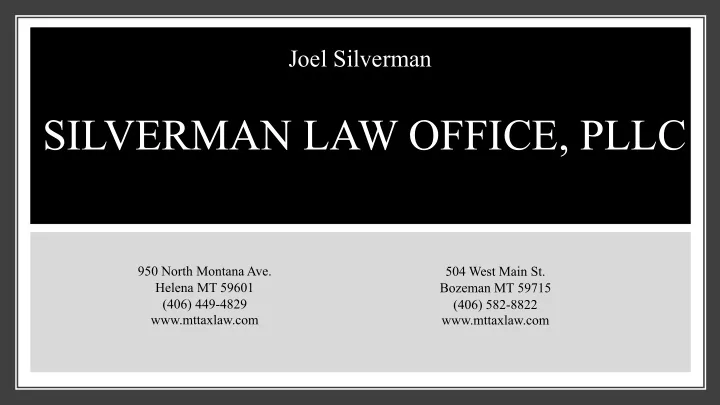

Joel Silverman SILVERMAN LAW OFFICE, PLLC 950 North Montana Ave. 504 West Main St. Helena MT 59601 Bozeman MT 59715 (406) 449-4829 (406) 582-8822 www.mttaxlaw.com www.mttaxlaw.com
6 Rules for Structuring 1031 Exchanges 01. Property Use Both your old and new property must qualify as investment or business use Holding Period for each is generally one year and one Day 02. 45-Day Identification Period From the closing of your sale to list the properties you may want to buy Must be in writing, signed, and provided to QI 03. 180-Day Exchange Period You have the Earlier of 180 days or the due date of your tax return to close on the purchase of one or more properties from the 45-day list 04. Qualified Intermediary (QI) Must purchase and take title to your new property exactly as you held title to your old property Use of single member LLCs may be permitted 05. Proper Title Holding Must purchase and take title to you new property exactly as you held title to your old property Use of single member LLCs may be permitted 06. Reinvestment Requirement To defer all of your capital gain tax, must buy a property equal or higher in value than the one you sold Must reinvest all of the cash proceeds from you sale
• “Section 1031(a) requires a comparison of the exchanged properties to ascertain whether the nature and character of the transferred rights in and to the respective properties are substantially alike .” • “In making this comparison, consideration must be given What is Like to the respective interests in the physical properties, the nature of the title conveyed, the rights of the parties, the Kind Real duration nature or character of the properties as distinguished from their grade or quality.” Property? Koch v. C.I.R., 71 T.C 54, 54, 65 (1978) Like, Not Identical
Commercial building and an unimproved lot (Burkhard Inv. Co. v. U.S., 100 F.2d 642 (9 th Cir. 1938) City real estate and a ranch or a farm (Treas. Reg. Sec. 1.1031(c)(2); Rutland v. C.I.R., T.C. Memo. 1977-8) Examples of Tenancy-in-common interest and a fee interest (Rev. Rul. 79-44) Like-Kind A fee and a leasehold with 30 Years or more to run (Treas. Reg. Sec. Real Property 1.1031(c)(2); Rev. Rul. 78-72) A remainder Interest in one property and a life estate in Another property where the life tenant has a life expectancy of at least 30 years (Rev. Rul. 78-4) A fee Interest and a condominium unit (Rev. Rul. 77-423)
A fee interest and a perpetual easement (PLR 9215049) Cell towers affixed to land and cable telecommunication signal distribution property affixed to land (PLR 201706009) More A fee interest and shares in a co‐op which includes a long‐term occupancy Examples of right (PLR 200137032) Like-Kind A fee interest and perpetual water rights (Rev. Rul. 55‐749) Real Property (Beware of the Weichens Case and limited duration) A fee interest and most mineral estates (Rev. Rul. 73‐428; Rev. Rul. 72‐117) A fee interest in land and a fee interest in land with unharvested crops (Rev. Rul. 59‐229)
• A leasehold of less than 30 years and a fee in another property (VIP Indus. Inc. v. C.I.R., T.C. Memo. 2013‐157) • A fee interest in land and building and a building only (at least in IRS’s view) (Rev. Proc. 2004‐51) Examples of • A fee interest in timberland and limited duration cutting Real Property rights (Oregon Lumber Co.v.C.I.R., 20 T.C. 192 (1953)) Which Are NOT • Water rights of limited duration and a fee interest (Wiechens v. U.S., 228 F. Supp. 2d 1080 (D. Ariz. 2002)) Like Kind : • Attached railroad track and unattached railroad track (TAM 200424001) ‒ A fee interest and a “carved out” mineral interest (i.e., a “production payment”) (C.I.R. v. P.G. Lake, Inc., 356 U.S. 260 (1958))
A More Recent IRS View • ILM 201238027 (Sept. 21, 2012) “[S]tate law property classifications are not determinative of whether property is of like kind. Rather, the Service should consider all facts and circumstances, including state law and federal tax law classifications as appropriate.”
Identical assets are like‐kind regardless of their classification under state law (however, now, it is critical to determine if such assets constitute “real property”). Resulting Where state laws classify assets Principles on differently, federal law will uniformly determine the “real vs. personal” What is Real property classification. Property Thus, assets classified under state law as real property may not belike‐kind to other real property regardless of comparable ownership rights.
Problem Areas in Exchanges “Qualified use” requirements‐holding property “Exchange” requirement‐not a sale & purchase “Boot” – equal or up in equity and debt Interplay of Section 121 exclusion Second or “vacation” homes Rev. Proc. 2008‐16 and 14 day de minimus rule
45 day identification period Changing identifications already made BUILD TO SUITE PROPERTY – revocation within 45 day period Replacement property received within Identification 45‐day period Issues To‐be‐built replacement property: identifying future improvements
Issues with adequate description Identification Issues (cont.) Partial interest in property (TIC) Acreage issues – 75% ‐ 125% rule Identification in the “alternative” or with maximum number of “finalists”
Related Party Exchanges • Rule: if an exchange transaction occurs between “related parties” and within two (2) years after the exchange, either party “cashes out”, both parties’ exchanges will be disallowed • Purpose: Prevent “basis shifting” between related parties
Related Party Exchanges (cont.) • Definition of “related party” • Lineal ancestors and descendants • Siblings • Entities and individual owners of 50% control (corporations, partnerships, LLC’s) • Corporations with common control (sister/brother affiliates) • Trust grantor or trustee and beneficiaries
Typical Forward Exchange
Typical Reverse Exchange
WHAT ARE THEY? HOW DO MY CLIENTS BENEFIT? OPPORTUNITY ZONES comdev.mt.gov https://www.irs.gov/newsroom/opportunity- zones-frequently-asked-questions
Joel Silverman SILVERMAN LAW OFFICE, PLLC 950 North Montana Ave. 504 West Main St. Helena MT 59601 Bozeman MT 59715 (406) 449-4829 (406) 582-8822 www.mttaxlaw.com www.mttaxlaw.com
Recommend
More recommend